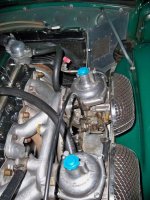I know this thread has been discussed before - I googled the problem - but after I finished my drive the other day I checked the dipstick. The oil looked fine and clear but there was a smell of gasoline on the stick. No leaking from the carbs evident so it might be the fuel pump at long last. Tank is about half full. Two questions:
1. How do I test the fuel pump for leakage?
2. TRF sells a pump for $125, Moss for about $35. Your choice? Or - should I just buy a repair kit and re-use the old original pump?
1. How do I test the fuel pump for leakage?
2. TRF sells a pump for $125, Moss for about $35. Your choice? Or - should I just buy a repair kit and re-use the old original pump?

 Hi Guest!
Hi Guest!

 smilie in place of the real @
smilie in place of the real @
 Pretty Please - add it to our Events forum(s) and add to the calendar! >>
Pretty Please - add it to our Events forum(s) and add to the calendar! >> 

